I’m re-introducing the delicious and nutritious yukgaejang to you today: spicy beef and vegetable soup. This soup is smoky, spicy, and rich, with healthy hunks of sliced beef and plenty of vegetables that are soft, but not mushy—they’re full of earthy mountain flavor from gosari (fernbrake). Served with rice, it’s a satisfying, warming meal.
I made a video for this recipe years ago. It was on my first low-def camera, and eventually the music was removed in a copyright claim. Even though the video was rough, the recipe was very good and many people used it to make delicious yukgaejang. I thought the time was right to remake the video in HD and rewrite the recipe.
When Koreans make yukagejang, they always make it in large batches to make it worth the effort. Extra yukagaejang is full of good stuff and never goes to waste: you can bring some to your friend’s house, or a close neighbor may get a knock at the door and find you there with some yukgaejang to share!
It’s also common for Korean moms to make a big pot of yukagaejang to keep their family sustained while goes away for an extended time. That way she can visit her own mom and not worry about her children and husband starving at home. It can keep in the fridge for 3 to 4 days, or up to 1 week if you reheat it every other day. One of my readers told me he divides it into portions and then freezes them, and then takes out a portion whenever he wants some for a meal. Good tip!
Homemade yukgaejang is always better than yukgaejang at a restaurant, because you can take care to add a lot of the best ingredients, perfectly prepared. Some restaurants might not include gosari, either. It’s an essential ingredient!
Enjoy my updated yukgaejang recipe and let me know how yours turns out!
Ingredients
Serves 4
- 1 pound beef brisket, cut into several pieces along the grain 3 inch long, soaked in cold water for 10 to 20 minutes, washed, and drained
- 4 dried shiitake mushrooms
- 1 medium onion, cut in half
- 12 ounces (about 3 cups) mung bean sprouts (you can grow your own!), washed and strained
- 3-4 large green onions (dae-pa) or 14-16 green onions, cut into 2½ inch long pieces
- 6 ounces of soaked (or fresh) gosari (about 2 cups), cut into 2½ inch long pieces
- 8 cloves of garlic, minced
Sauce
- ¼ cup Korean hot pepper flakes (gochugaru)
- 1 tablespoon kosher salt
- 1 tablespoon soy sauce
- 1 table spoon toasted sesame oil
- 1 tablespoon olive oil (or any cooking oil)
On the side
- Extra kosher salt
Directions
Start cooking the beef, mushrooms, and onion:
- In a large pot, bring 3 quarts (12 cups) of water to a boil. Add the beef along with the dried shiitake mushrooms and the onion.

- Cook for 1 hour over medium high heat.
While it boils, make the seasoning sauce and prepare the vegetables:
- Combine the sauce ingredients in a bowl and mix it well.

- Cover with plastic wrap and set aside.
- Put the mung bean sprouts, green onions, gosari, and garlic in a large bowl.

Make the soup:
- 1 hour later, check the beef. Take a sample chunk and split it with your fingers or fork. If it splits nicely, it’s done. If it’s a little tough to split, let it cook for 10 more minutes. As stock boils off, you want to maintain about 10 cups’ worth, so add some water.
- When it’s done, remove the beef, onion, and mushrooms with a slotted strainer.
- Let the beef and mushrooms cool down and discard the cooked onion.
- Mix the vegetables with the seasoning sauce by hand until well incorporated. Add to the boiling stock.

- Cover and cook 20 minutes over medium high heat until the vegetables are cooked through and tender, but not mushy.
- Slice the mushrooms and pull the beef apart into strips. Add to the boiling soup and cook another 10 minutes.


Serve:
Maangchi's Amazon picks for this recipe
It's always best to buy Korean items at your local Korean grocery store, but I know that's not always possible so I chose these products on Amazon that are good quality. See more about how these items were chosen.



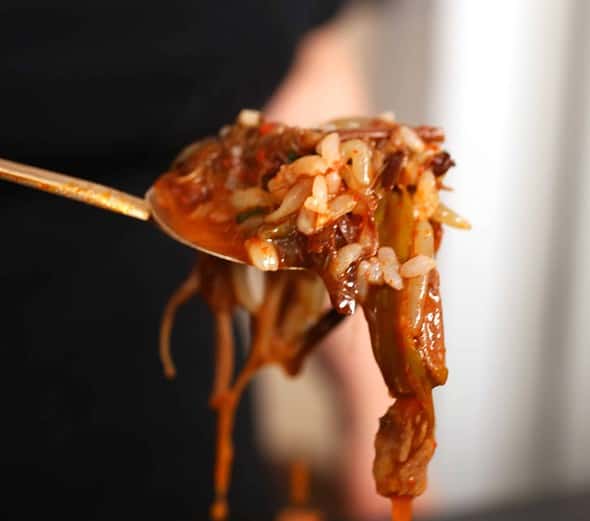
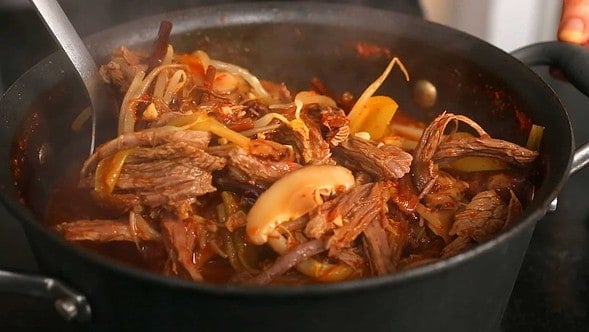
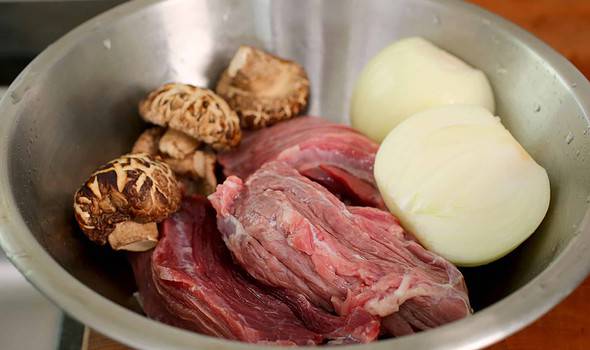
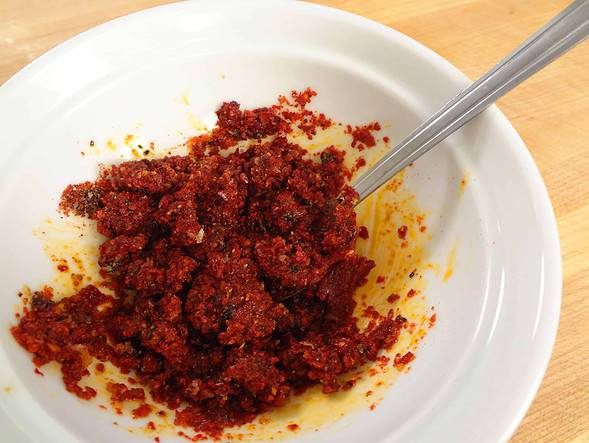
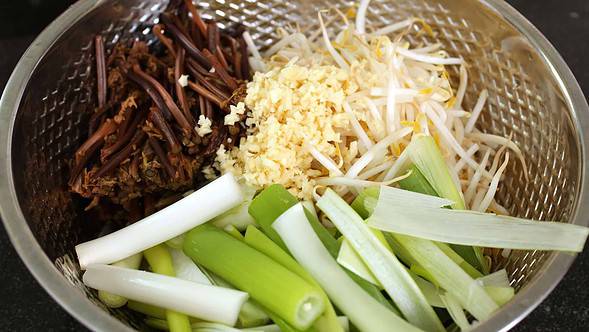
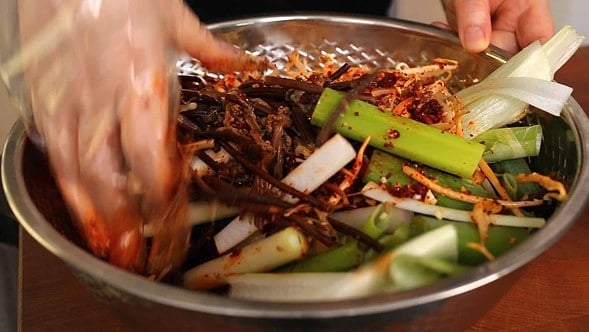
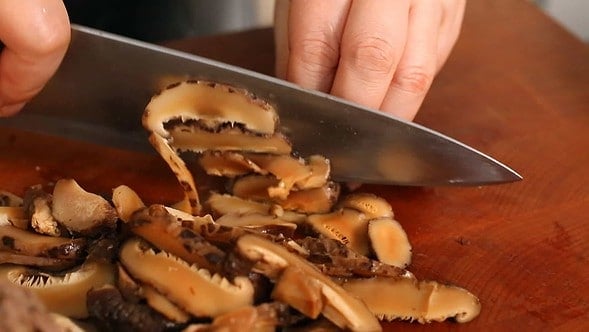
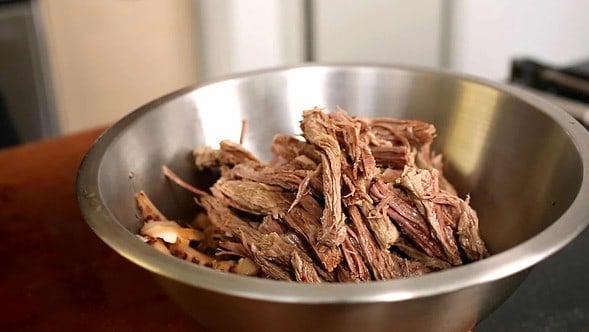
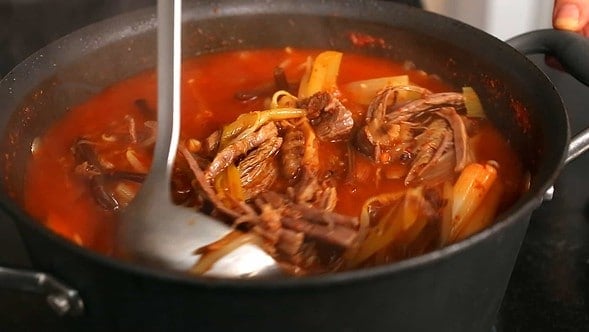








![[OTTOGI] Premium Roasted Sesam...](https://m.media-amazon.com/images/I/41DixbNS9AL._SL160_.jpg)
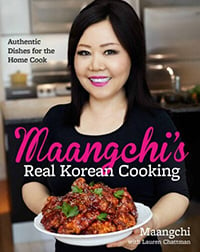
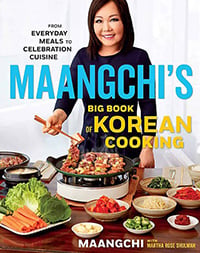




















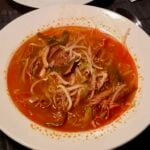
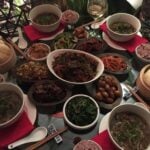
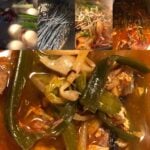
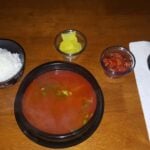
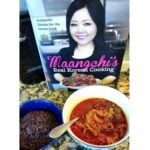

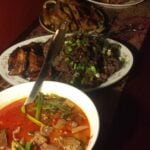

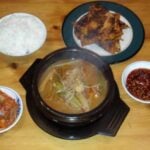
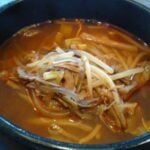
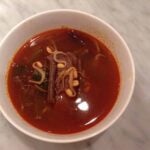

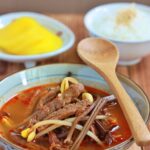

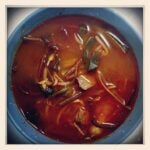
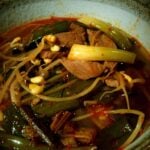
This is the next recipe of yours I’m going to make, I made cheese buldak today.
I find it funny that other mums would make something to last for days if she was gone, my mum if she was going away for some days would leave us to fend for ourselves. We would have to make dinner ourselves if we wanted dinner that day. It probably helped that my dad always liked puttering around the kitchen and I inherited that. It was my dad that taught me to cook, not my mum. She isn’t a bad cook but it’s all very tame in my opinion. She would never try her hand at some Korean food, she is however very good at baking!
When I was 12 I was home for the summer with just my siblings, both older than me, whilst my parents were at our cabin, I have serious pollen allergies and our cabin is surrounded by woods. Despite being the youngest I was the one fixing dinner and making sure my siblings ate and came home at night.
I can’t find 고사리 in the korean food store where I live and I can’t find it to ship online , is there anything I could subsitute it for? (I begrudge doing it )
Hi Maangchi,
Here my comment on my Yukgaejang: It turned out very god with the following small changes:
1. When it was finished, I added 3 mixed eggs carefully in the soup, when it was not more boiling. Then I waited for 30 Minutes and mixed the soup up, very good!
2. I let the soup cool down and waited 24 hours, before eating it.
3. I added much more salt and very hot Chili flakes. It must be so hot, that you sweat when eating it.
4. I served it with rice ( as you say ) and some glass noodles, as I am a great noodle lover, this was also very good.
5. The rest is going into the deep freezer and so I can enjoy the soup later in the year again and this has the big advantage, that you do not smell all those ingredients before, when you cooking it.
Thanks again for that wonderful recipe
Tido
As it says in the recipe: “6 ounces of soaked (or fresh) gosari (about 2 cups), cut into 2½ inch long pieces”, complete with the link how to prepare it: https://www.maangchi.com/ingredient/kosari
Don’t you have any books about Korean cooking? A recipe for this beef soup is almost always there…
Bye, Sanne (München)
Hello Maangchi,
When I was 25 years old, I used to go together with my wife to a fantastic korean Restaurant in Wuppertal, Germany and we used to eat Yukgaejang there, the best soup of the world! It was extremely spicy but absolutely great in taste. They served it with rice and Kimchi! When I was 40, I went there again with my wife, but this was the last day of the restaurant, before it closed for ever. Now I knew, that I would never get this soup again and I offered them 400 DM ( the currency before EUR , about 250 $ ) for the recipe, but they didn’t give it to me, unfortunately. Now I am 57 years old and found your recipe on your page, I am absolutely fascinated! On the next weekend I will try it!
Now some questions: I can get gosari here in a Korean shop in Düsseldorf, but it is dried. Can I cook it up for 30 Minutes and let it rest over night before using it?
I remember, there were eggs in that soup in that restaurant. Can I add, shortly before it is finally finished, 2 mixed eggs into the soup and wait for 10 Minutes?
Can I also use Turande instead of gosary or gosari and Turande?
I am very excited now and can hardly wait to the weekend, when I will try it.
I will let you know, how it was, thank you so much!
All the best,
Tido
Hi Tido,
I hope you love my yukgaejang recipe. You must be so passionate about delicious food, just like me!
“I can get gosari here in a Korean shop in Düsseldorf, but it is dried. Can I cook it up for 30 Minutes and let it rest over night before using it?”
Just as Sanne replied, follow the link and you can see how to soak your gosari to make it tender. If you have a pressure cooker, you can boil your gosari for 30 to 40 minutes and then rinse it in cold water before using it right away. This is what I do, these days.
I think your egg idea sounds good, try it!
You can also use both torandae (taro stems) and gosari together.
Good luck with making delicious yukgaejang!
Hello Maangchi! After years of following you and trying out your recipes which my family and friends always enjoy I just want to say Thank You! Your recipes are part of the lovely memories I made and are still making with my 6 years old son, his Dad, my friends and relatives… Thank you! I’d be glad to meet you the next time you visit Philippines… ❤️
I love this soup but I’m not a big fan of gosari. Can you recommend other vegetables that will go well?
Add more green onions and mushrooms.
Hello Maangchi,
Bought your book the other day but still prefer your videos!
What is your opinion of using mung bean sprouts instead of soy bean sprouts?
Great! You won’t miss any cooking! I use mung bean sprouts in this recipe.
Hi Maangchi,
Thank you again for being such a great inspiration. You make cooking process look easy..
I am about to make yukgaejang as it’s been my favorite soup since I was in college. I definitely prefer this than kimchi jiggae. But if my friend gave me both, I would love to clean them up too :p
My question is, is it OK to add vegetable that’s been seasoned after we reboild the chopped mushroom and beef? Will it change the taste or something? Because I wanna eat kind of crunchy mung bean sprout and green onion. I just thought that boiling them over 10min will make them mushy..
Look fwd to your reply as I am preparing the ingredients now. Million thanks Maangchi
Hi Maangchi! This is, by far, my favorite recipe. I’ve been a silent reader and have been watching your videos for over a year now. I just watched your 1 million viewers video and am so happy and excited for you as you deserve that and so much more! I literally cried happy tears as I watched it!! As all others have said before me, I get so happy when I watch you cooking. Your excitement and joy is so evident in your videos. Thank you for bringing me so much joy in my life, especially on days when I feel down. Sending you hugs and kisses. And congratulations on your achievement!!!
And yes, I entered the t-shirt contest but I also hope you think about selling them too. I’m sure a lot of people will buy them!! I know I will.
Hello, hello! You are one of my 1 million subscribers! Thank you so much for your nice words here! Cheers!
Hello, Maangchi! In your old video for this recipe you mentioned an ingredient “toran” or taro stem. My local H-Mart sells dehydrated taro stems. Would it still be good to use them in this recipe? Would I need to soak them first?
Dehydrated taro stems are difficult to handle. You will have to boil and soak for a long time, changing water several times.
I did once at home and made toran-julgi-bokkeum (taro stem side dish). The texture was soft and crispy and it was flavorful but I realized the poison in the stems was not totally removed even though I soaked them for 2 days. My throat was hurt for a couple of hours. Ever since then, I am afraid to cook toran julgi. Toran fruits are good because all the poison is gone after they are boiled. https://www.maangchi.com/recipe/toran-guk
Maangchi, have you ever tried using fresh taro stems instead? The texture might be different from dried but it is much easier to use. Vietnamese markets sell fresh taro stems (bac ha) for making Vietnamese sour fish soup.
Oh wow! Thank you so much for the information. I’ll stick to making the soup without the stems. Thank you for taking the time to answer. :)
Hello Maangchi!! I searched for some recipes of korean food but some of them at youtube i didn’t really like but today i found your videos and i loved them!! i have to cook immediatly!! :) thanks for your great videos!!
I saw your video when I woke up today and knew I just had to make it. I attached a picture of the finished product so you can see. I’m going to eat it for the entire week! I’m so excited!! Thank you for your delicious recipe and awesome video. :) <3
See full size image
You made absolutely delicious and hearty yukgaejang! I’m so happy to see it!
Hi Maangchi! I love yukgaejang and I can’t wait to try out your recipe! I had one question however…usually when I order it in restaurants, it has dangmyeon in it, and for me that’s one of the big reasons I like it (I’m a huge noodle-lover!), so I was just wondering when you might suggest adding the dangmyeon if I were to add it? Thank you :)
I’m a huge noodle lover, too! : ) You can add sweet potato starch noodles (dangmyeon) to yukgaejang. If you do, add them at step 6 in the recipe along with beef and mushrooms. The noodles will expand and get soggy in the soup if you don’t eat the soup quickly though.
Hi there. I love your site and your recipes. I make this dish for my Korean wife often and she loves it.
I think there is one small mistake in your ingredients. You call for 5 tsp of salt. I think this is far too much and I think it must be a typo. I added 3 1/2 the first time I made it an it was crazy salty. I’m now down to 1 tsp of salt and 1 tbsp of beef broth powder.
Also, I double the ingredients (except the salt) in the “hot pepper oil sauce” and that suits our tastes better.
Maangchi,
Hello! I am 100% Italian, with a 100% Korean boyfriend that I just moved in with :) I have never cooked Korean food before (but have cooked many other Asian dishes in the past). I wanted to surprise him with something, and I tried this soup today for the first time. HE LOVED IT, and did not stop praising me! The only ingredient that I did not have on hand was the kosari, but I substituted it with asparagus, since I had nothing else. I also left out half of the red pepper, but added some Nam Prik Pao for flavor. I am looking forward to making him more recipes from your site, and thank you for helping me with my first Korean cooking experience!
See full size image
I’m very happy to hear that your “100% Korean” boyfriend kept praising you while he was eating your yukgaejang! : ) You can replace gosari with sliced mushrooms and use lots of green onions.
Boiling the brisket at a such a high temperature results in tough meat. Slicing it thinly does help. However, to make the meat more tender, I treated the soup just as I would an Italian bolognese sauce. After adding the sliced brisket at the end, I kept the soup at a low simmer for several hours. This did not appear to overcook the vegetables or affect their texture too much because they are very fibrous to begin with (especially the toran).
however, the slow cooking breaks down the connective tissue in the meat further and makes for a more tender brisket (any barbecue chef will tell you that “slow and low” is the best way to cook a brisket anyhow).
I ate YukGaeJang regularly when I lived in Korea. I couldn’t figure out how to make it spicy enough. Everyone prepares it differently, but my favorites were always the ones that made me sweat (if it doesn’t make me sweat, then it isn’t spicy!). I bought some chiles at the Korean market and, instead of slicing them whole and incorporating them into the soup, I cut them into quarters and put them in a cheese cloth sachet –steeping them as you would a tea, while the stock simmered. I thought the peppers were tougher than normal and I did not want to add them into the soup sliced or otherwise. This method added heat and flavor, but not the tough flesh.
My Korean wife loves this recipe. Thanks. Also, your ddeok bboki recipe is the best! I haven’t tried to make my own ddeok yet, but that is on my todo list.
Maangchi,
I have tried numerous recipes from you and they are all tasty, thank you!
Today I tried yukgaejang and it is quite different from the one I tried from a food court at H Mart in Bayside, NY. Have you been to that food court before? I can’t tell where is the difference, I don’t think it is because of MSG.
aamomo
I loved most every dish I ate when I was in Korea. This soup was always my favorite during the colder months. I would rotate between this and the spicy squid at lunch constantly. I am finally glad to have the recipe so I can finally make my own. I will be trying my hand at a lot of your recipes. Thanks!
Maangchi,
육개장 맛있어요! I had a hankering for some hot and spicy soup and I had some beef left over from Bulgogi last weekend. So I made Yukgaejang! I had enough left over so I will put some in the freezer and see how that works.
감사합니다!
Dave
Hi Dave,
Awesome! “I had enough left over so I will put some in the freezer and see how that works.” Let us (me and my other readers) know the result! I usually keep my leftover yukgaejang in my fridge up to 1 week and I never freeze it.
Maanchi,
Will do! I will try it after one month and let you know how it tastes! I am sure it will still be delicious. My wife does this with many soups and stews and they always come out good! She also makes a lot of homemade broths and stocks (fish, chicken, turkey, vegetable) and freezes those as well.
Cheers!
Dave
Maangchi,
As promised, here is my report on yukgaejang in the freezer. I knew it would be good, but it was even better than I expected! I defrosted it yesterday, heated it up on the stovetop for lunch today. Once it was ready, I dumped some rice in. It was delicious! The flavors melded and tasted even richer. I would say that it was an unqualified success! Now I can make larger batches, freeze it and have it anytime! ^^
감사합니다!
Dave
Thank you for updating your yukgaejang! “Once it was ready, I dumped some rice in.” yay! That’s what I do! : )
Great recipe! I made this but needed much more (3X) the red pepper/oil sauce to make it spicy like here in Busan.
Hi Busan dweller,
yes, you can modify the amount of hot pepper flakes to your taste! Good job!
I love this recipe! Thank you so much!
Annyeonghaseyo eonni! ^o^
I am a fan of Korean delicacies, and THIS RECIPE IS JJANG! Thanks a lot for sharing this recipe! I love the taste and the ingredients are quite simple, & quite easy to make.
Anyway I did a little experiment with this recipe. I cooked this recipe using 2 different method :
1. Following your recipe, the soup came out very refreshing, & of course very delicious!
2. After some experience, instead of using water only, I mixed with SOY MILK! The ratio is around 50:50 with water. Surprisingly, it turned out WONDERFUL. The taste come out savoury & great.
I can’t wait to try cooking the other recipes. Wish me luck..!!
Gamsahabnidaaaaa~
Maangchi! :) will this soup still taste good without gosari??
yes, it’s still good, you can add some mushrooms as well. I also put some eggs (break it and put it slowly in the boiling soup) for the last touch into the soup. really delicious!! :)
Where I live the Korean store has 토란. How do I cut it?
What side dishes would you pair with the soup, beside rice?
How about soy bean sprouts side dish and spinach side dish?
https://www.maangchi.com/recipe/kongnamul-muchim
https://www.maangchi.com/recipe/sigumchi-namul
If you want more, choose some from here. https://www.maangchi.com/recipes/sidedishes
I made this with the Kosari soaked in water. It soup was a little sour . Is it suppose to be????
no, it shouldn’t taste sour. https://www.maangchi.com/talk/topic/question-on-kosari
One quick question – I love adding mushrooms to all my dishes. Would it be improper to add a few different types of mushrooms with the soup? Or would that take away from the flavor?
My favourite Korean dish, I made it yesterday for the first time by myself-
omg, it was sooo good ! And it tastes even better the next day when you reheat it :) !
ow ow, I know how you felt! You must have been proud of yourself! Yes, I’m proud of you, too!
Wonderful recipe!! Perfect for fall/winter! Thank you for the recipe!! I think I added too much ingredients and not enough soup so I have lots of left over without soup. I think I’ll add more water and make more soup to eat leftovers!
I’ve made this a couple of times now, and it’s really become one of my favorite soups. I’ll add that while the recipe as given here is huge, that’s not at all a bad thing, as like many soups this actually gets better at second warming. It also freezes quite well. I’ve gotten in the habit of making this any time I see brisket or other tough cuts of beef on reduced price and freezing up the leftovers.
maangchi unnie.. kkk.. I made yukgaejang with your recipe.. and I proudly present my blog post of it!
http://edreasjourney.wordpress.com/2010/11/27/my-yukgaejang/
By the way, I could find dried Toran, so I used that instead =)
Thank you for the recipe!!
Just wondering – if adding an egg or two at the end (like some restaurants do) – do you just beat the eggs first, and then with the soup cooking, just pour in the beaten eggs so it become strands? What is your official advice for adding egg at the end?
Thanks
After months of eying your site, I finally followed a Maangchi recipe to try to remake one of my favorites, yook gae jang. My friends and family warned me it was a time-consuming dish so I was relunctant to attempt this. But I made it and when I tasted the broth, I felt a tad let down until I realized I had forgotten the 7 garlic cloves you put in during your video lesson! After I put that ingredient in, the broth tasted so much better! Much more fuller! And NO MSG, I love it! Of course, I did add a couple serrano chiles and some more spoonfuls of red pepper flakes because I like my food verrrry spicy….
hi I went to the Korean grocery once and I saw something that looked like dried kosari, but on the bag it said ‘sweet potato stems’ or something like that. Do you know what it is (perhaps bad translation of kosari?) and how to prepare it? Sorry I don’t have a photo, perhaps I will buy it next time just to be curious.
Hi, i know what you mean i saw this product too before, but they are different things. I don’t know an application for the ‘sweet potato stems’.
Kosari usually has ‘fernbrake’ or ‘dried bracken’ on the package.
Yes, “sweet potato stems” is different from kosari. I think the bag of dried vegetables is sweet potato stem as it says. It’s called “goguma julgi namul” in Korean. You will have to soak it in warm water overnight and cook it just like dried kosari. https://www.maangchi.com/ingredients/kosari
I will post the recipe for sweet potato stems someday in the future.